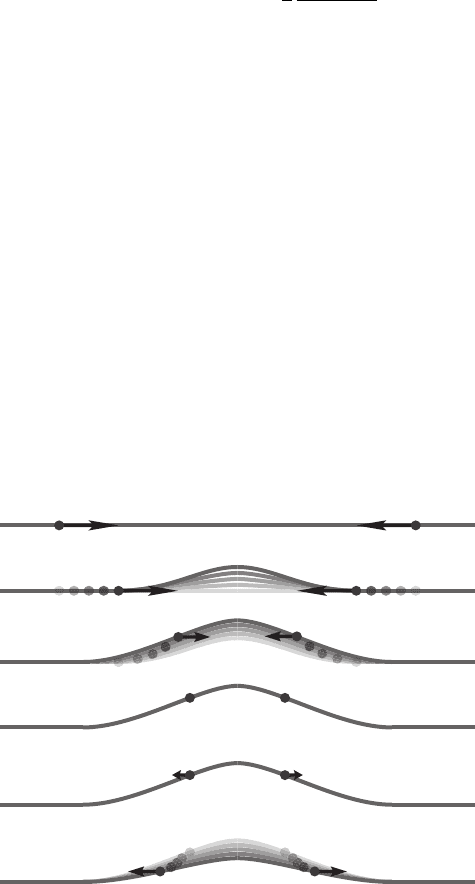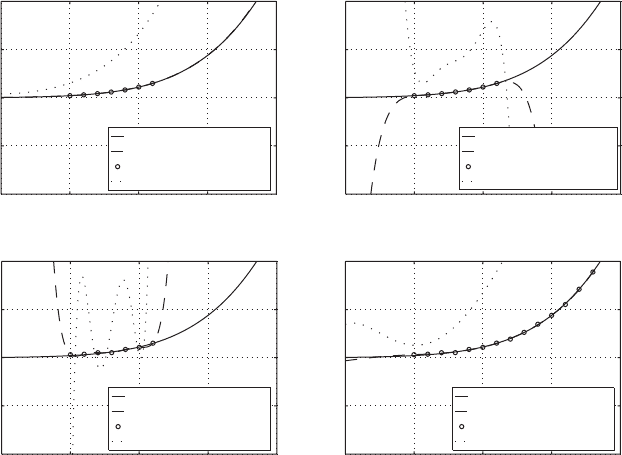Chattaraj P.K. (Ed.) Quantum Trajectories
Подождите немного. Документ загружается.

344 Quantum Trajectories
4. D. Bohm, B. J. Hiley, and P. N. Kaloyerou, Phys. Rep. 144 (1987) 321.
5. D. Bohm and B. J. Hiley, The Undivided Universe, Routledge, London, 1993.
6. P. R. Holland, The Quantum Theory of Motion, Cambridge University Press, New York,
1993.
7. R. E. Wyatt, Quantum Dynamics with Trajectories: Introduction to Quantum Hydrody-
namics, Springer, New York, 2005.
8. C. Lopreore and R. E. Wyatt, Phys. Rev. Lett. 82 (1999) 5190.
9. R. E. Wyatt and E. R. Bittner, J. Chem. Phys. 113 (2000) 8898.
10. K. H. Hughes and R. E. Wyatt, Chem. Phys. Lett. 366 (2002) 336.
11. B. K. Kendrick, J. Chem. Phys. 119 (2003) 5805.
12. B. K. Kendrick, J. Molec. Struct.: THEOCHEM 943 (2010) 158–167.
13. J. Von Neumann and R. D. Richtmyer, J. Appl. Phys. 21 (1950) 232.
14. D. K. Pauler and B. K. Kendrick, J. Chem. Phys. 120 (2004) 603.
15. S. W. Derrickson, E. R. Bittner, and B. K. Kendrick, J. Chem. Phys. 123 (2005) 54107-1-9.
16. B. K. Kendrick, J. Chem. Phys. 121 (2004) 2471.
17. V. A. Rassolov and S. Garashchuk, J. Chem. Phys. 120 (2004) 6815.
18. S. Garashchuk, J. Phys. Chem. A 113 (2009) 4451.
19. C. J. Trahan, K. Hughes, and R. E. Wyatt, J. Chem. Phys. 118 (2003) 9911.

22
Bohmian Grids and the
Numerics of Schrödinger
Evolutions
D.-A. Deckert, D. Dürr, and P. Pickl
CONTENTS
22.1 Introduction.................................................................................................345
22.2 Problems of the Numerical Implementation...............................................349
22.3 Fitting Algorithms: What They Can Do and What They Can’t ..................352
22.4 A Numerical Example in MATLAB
........................................................355
Bibliography ..........................................................................................................359
22.1 INTRODUCTION
Bohmian mechanics [1, 2] is a mechanical theory about the motion of particles. In
contrast to quantum mechanics, Bohmian mechanics is a complete physical theory
which leaves no interpretational freedom; in particular, it is free of paradoxes like
Schrödinger’s cat. This completeness is achieved by introducing a definite configu-
ration of particles for all times which is governed by the Bohmian velocity law. The
predictions of Bohmian mechanics agree with those of quantum mechanics when-
ever the latter are unambiguous. Besides that, it turns out that in some situations
the Bohmian velocity law is a convenient tool for the numerical integration of the
Schrödinger equation. There is a lot of literature which explains the physical side
of Bohmian mechanics, see e.g. Ref. [2]. The role of this chapter is to explain the
advantages in using Bohmian mechanics for numerics.
Let us discuss the Bohmian equations of motion in units of mass m = = 1. First,
one has the Schrödinger equation
i
dψ
t
(x)
dt
=
−
∇
2
x
2
+ V (x)
ψ
t
(x) . (22.1)
Here x = (x
1
, ...,x
N
) denotes the configuration in configuration space R
3N
. Fur-
thermore, we use the notation ∇
x
= (∇
x
1
, ...,∇
x
N
) where ∇
x
k
is the gradient with
respect to x
k
∈ R
3
.
Let ψ
t
be a solution of the N -particle Schrödinger equation with initial condi-
tion ψ
t
$
$
t=0
(x) = ψ
0
(x). Given the initial positions q
0
1
, ...,q
0
N
of the particles, the
Bohmian velocity law then determines the positions q
1
(t), ...,q
N
(t) of the particles
345

346 Quantum Trajectories
at any time t. In this way Bohmian mechanics describes for given ψ
t
and any given
initial configuration q(0) := (q
0
k
)
1≤k≤N
the motion of the configuration space trajec-
tory q(t) := (q
k
(t))
1≤k≤N
. Note that one such configuration space trajectory describes
the motion of all N particles.
The trajectories of the N particles q
k
(q
0
k
, ψ
0
;t) ∈ R
3
,1≤ k ≤ N , are solutions
of the Bohmian velocity law
dq
k
(t)
dt
= Im
ψ
∗
t
∇
q
k
ψ
t
ψ
∗
t
ψ
t
(q
1
, ...,q
N
)
(22.2)
with q
k
(t = 0) = q
0
k
as initial conditions and ψ
∗
denoting the complex conjugate
of ψ, so that ψ
∗
ψ =|ψ|
2
. Interpreting ψ
∗
ψ as an inner product, the generalization
to spin wavefunctions is straightforward [2]. Using configuration space language the
Bohmian trajectory of an N particle system is an integral curve q(t) ∈ R
3N
of the
following velocity field on configuration space
v
ψ
(q, t) = Im
(ψ
∗
t
∇
q
ψ
t
)(q)
(ψ
∗
t
ψ
t
)(q)
, (22.3)
i.e.,
dq(t)
dt
= v
ψ
(q, t). (22.4)
Statistical Bohmian Mechanics. Like in quantum mechanics the exact initial con-
figuration q
0
of the N particles is unknown. One usually starts with a probability dis-
tribution for the initial configuration given by the density |ψ
0
|
2
(Bohmian mechanics
explains why, see Ref. [2, 3]).
Therefore, in Bohmian mechanics one has to consider an ensemble of many con-
figuration space trajectories which is initially |ψ
0
|
2
-distributed. Each of these config-
uration space trajectories describes a different possible physical time evolution of all
the N particles and must not be confused with different one-particle trajectories.
Under general conditions one has global existence and uniqueness of Bohmian
configuration space trajectories, i.e., the integral curves do not run into nodes of the
wavefunctions and they cannot cross [4]. The uniqueness, i.e., non-crossing property,
is due to the fact that the Bohmian law is given by a velocity vector field: at each
configuration point there is a unique vector, prescribing the velocity of the config-
uration in that point. To avoid misunderstandings it is important to emphasize that
the non-crossing of Bohmian configuration space trajectories has nothing to do with
possible crossings of particle paths. The crossing of particle paths is in fact allowed
in Bohmian mechanics. For example the situation where two particle paths cross at
time t
0
is described by just one Bohmian trajectory: at time t
0
the position of both
particles is equal, let’s say x
0
, i.e q(t
0
) = (x
0
, x
0
).
To analyze Bohmian mechanics statistically we must introduce an ensemble den-
sity ρ(q, t). Such a density fulfills the continuity equation, which for the Bohmian
flow reads

Bohmian Grids and the Numerics of Schrödinger Evolutions 347
∂ρ(x, t)
∂t
+∇
x
ρ(x, t )v
ψ
(x, t )
= 0.
The empirical import of Bohmian mechanics arises now from equivariance of the |ψ|
2
-
measure: one readily sees that by virtue of (Equation 22.3) the continuity equation
is identically fulfilled by the density ρ(x, t) =|ψ(x, t)|
2
, known as the quantum flux
equation,
∂|ψ(x, t)|
2
∂t
+∇
x
|ψ(x, t )|
2
v
ψ
(x, t )
= 0.
In contrast to Hamiltonian statistical mechanics where typical trajectories are
described by stationary measures (like microcanonical or canoncial distributions)
in Bohmian mechanics the typical trajectories are described by the equivariant mea-
sure ρ(x, t) =|ψ(x, t)|
2
. In other words the notion of equivariance replaces the notion
of stationarity. This means that if one looks at an ensemble of Bohmian trajectories
such that the respective initial configurations q(0) = (q
0
1
, ...,q
0
N
) are distributed
according to ρ
0
=|ψ
0
(x
1
, ...,x
N
)|
2
at time t = 0, then for any time t the config-
urations q(t) = (q
1
(q
0
1
, ψ
0
;t), ...,q
N
(q
0
N
, ψ
0
;t)) are distributed according to ρ
t
=
|ψ
t
(x
1
, ...,x
N
)|
2
. Because of this, Bohmian mechanics agrees with all predictions
made by orthodox quantum mechanics whenever the latter are unambiguous [3,5].
Hydrodynamic Formulation of Bohmian Mechanics. In this section we recast the
Bohmian equations of motion in a form which is suitable for numerical analysis.
We first write ψ in the Euler form
ψ(x, t ) = R(x, t )e
iS(x,t)
where R and S are real-valued functions. Equation 22.3 together with Equation 22.1
separated into their real and complex parts gives the following set of differential
equations (which are very much analogous to the Hamilton–Jacobi equation of
Hamiltonian mechanics)
dq
dt
=∇
q
S(q, t)
∂R(x, t)
∂t
=−
1
2
∇
x
(R(x, t)∇
x
S(x, t))
∂S(x, t)
∂t
=−
1
2
(
∇
x
S(x, t)
)
2
− V (r) +
1
2
∇
2
x
R(x, t )
R(x, t )
.
We now introduce the functions R(t), S(t) defined by replacing the configuration point
x by the configuration space trajectory q(t):
R(t) = R(q(t), t) S(t) = S(q(t), t).
Taking the derivatives with respect to time, for example,
dR(q(t), t)
dt
=
∂R(q(t), t)
∂t
+
∂R(x, t)
∂x
$
$
$
$
x=q(t )
dq
dt

348 Quantum Trajectories
yields, using the notation q = q(t),
dq
dt
=∇
q
S(q, t) (22.5)
∂R(q, t )
∂t
=−
1
2
R(q, t)∇
2
q
S(q, t) (22.6)
∂S(q, t)
∂t
=
1
2
dq
dt
2
− V (q) +
1
2
∇
2
q
R(q, t)
R(q, t)
. (22.7)
Numerical Integration. To solve a differential equation like the Schrödinger equa-
tion numerically one has to first discretize the problem. Instead of the full function
ψ(x, t ) where x varies in configuration space R
3N
one considers ψ(x
k
, t
l
) where
x
1
, ...,x
n
and t
1
, ...,t
m
are discrete “grid” points in configuration space and on the
time axis.
When choosing the grid one has to take care of the following two things:
• The values ψ(x
k
, t
l
) define an approximation
8
ψ for ψ. For example one could
think of
8
ψ(x, t ) = ψ(x
k
, t
l
) where for x
k
one chooses the grid point closest to
x and t
l
closest to t (as explained later one usually employs a fitting algorithm
to compute the numerical approximation
8
ψ from the discrete data points
(ψ(x
k
, t
l
)
1≤k≤n,1≤l≤m
). To reproduce from this discretization the physically
relevant features of the full wavefunction one has to take care that the relevant
regions in configuration space are well covered by the grid points.
The sense of approximation needed in physics is the L
2
-distance, i.e., in
the above example
|
8
ψ(x, t ) − ψ(x, t)|
2
dx
1/2
. (22.8)
• Of course the choice of grid points also influences the propagation of errors,
as for example, the accuracy in computing derivatives depends on the grid.
In the usual approaches the grid points are fixed once and stay fixed for all times.
Here one would have to densely distribute grid points in all regions of configuration
space where the wavefunction may have support during the whole time interval of
interest (this region is, when not confined to a potential trap, usually unknown).
This has the disadvantages that:
• Once the grid is fixed there may be regions in configuration space into which
the wavefunction propagates and which are not covered by grid points.
• On the contrary there might be regions in configuration space where the
wavefunction never lingers or stays only for a short time. Including such
grid points in the computation for all times only slows down the numerical
simulation without leading to better accuracy.
Bohmian Grids. One idea of avoiding these problems is to introduce a time depen-
dent grid which is adapted to the time evolution of ψ
t
. For Equation 22.8 the natural
Bohmian Grids and the Numerics of Schrödinger Evolutions 349
choice for the grid point trajectories for the Schrödinger equation are the Bohmian
configuration space trajectories. To understand this recall equivariance: choosing the
initial grid points |ψ
0
|
2
-distributed guarantees that they will stay |ψ
t
|
2
-distributed for
all times.
This co-moving grid spreads dynamically according to the spreading of |ψ
t
|
2
and
the grid points will primarily remain in regions of space where |ψ
t
|
2
is large while
avoiding regions of nodes or tails of |ψ
t
|
2
which are numerically problematic and
physically irrelevant. The support of the wavefunction is then for all times well cov-
ered by grid points and there are only a few grid points in the physically uninteresting
regions of configuration space, i.e., in regions where |ψ
t
|
2
is small.
Such grids naturally optimize the approximation of the wavefunction in the sense
of Equation 22.8. This idea goes back to Bob Wyatt [6]: instead of considering the
equations on a fixed grid one regards the set of Equations 22.5 through 22.7 which
can be integrated simultaneously and give the best adapted co-moving grid on the fly.
Wyatt’s algorithm is particularly interesting for:
• Long-time simulations in scattering situations which usually (for methods
using a fixed grid) demand a huge number of grid points and therefore a
huge computational effort.
• Simulations of entangled oligo-particle systems which usually either neglect
entanglement and give inaccurate results or demand huge computational
effort since one has to consider grid points in all 3N dimensions of a con-
figuration space of N particles.
In order to perform the numerical integration of the set of differential Equa-
tions 22.5 through 22.7 we follow the straightforward method described in Ref. [6].
The only crucial part in this is computing the derivatives involved in the set of dif-
ferential equations which we shall discuss below in detail.
22.2 PROBLEMS OF THE NUMERICAL IMPLEMENTATION
The quality of the numerical implementation can be measured in terms of the proper
motion of the grid points which ideally should move along the Bohmian config-
uration space trajectories. Once they deviate from the latter equivariance will be
violated, which means that the numerical approximation becomes bad in the L
2
sense
(Equation 22.8).
The motion of the simulated grid points can go bad:
• when the grid point trajectories approach each other;
• when the wavefunction develops nodes;
• at the boundary of the grid.
We shall explain: Whenever two Bohmian configuration space trajectories
approach each other the Bohmian time evolution will prohibit a crossing of them
(because otherwise uniqueness would be violated). The mechanism which pre-
vents crossings may however fail in numerical simulations due to numerical errors.

350 Quantum Trajectories
Therefore, it is vital for stable numerical simulations to understand this mechanism
in terms of the dynamics given by Equations 22.5 through 22.7. The important term
which is responsible for the mechanism to work is the quantum potential in Equa-
tion 22.7:
1
2
∇
2
q
R(q, t)
R(q, t)
. (22.9)
Thinking of equivariance the particles are always |ψ
t
(x)|
2
-distributed, thus the
approach of two particles goes hand in hand with an increase of |ψ
t
(x)|
2
at the posi-
tions of the two particles. This leads to a bump in R(q, t) on the microscopic scale
defined by the grid points. At such a bump, ∇
2
q
R(q, t) is negative of course, and a
negative quantum potential ∇
2
q
R(q, t)/R(q, t) in turn accelerates the two approaching
grid points away from each other by virtue of Equation 22.7 and in this way prevents
crossings (see Figure 22.1).
Anumerical simulation which does not reproduce the derivatives on a microscopic
level is not sensitive to bumps. Thus it does not prevent the crossing of grid point
trajectories. Also the time step has to be chosen sufficiently small, at least a few
times smaller than the distance of two approaching grid points divided by the relative
Bohmian velocity. Otherwise there might not be enough iterations for the quantum
potential to decelerate the approaching grid points.
Things can go wrong in particular when R(q, t) is very small: a small value of
R(q, t) can cause a large quantum potential (Equation 22.9) and therefore large accel-
erations resulting in large velocities.
Typical situations where R(q, t) is small are “nodes” and “tails” of the wavefunc-
tion. Nodes are local zeros of the wavefunction and tails are extended regions in
1. Two grid points which
approach each othert
2. Formation of a
microscopic bump in |ψ|
3. e quantum
potential recognizes this
increase in curvature
4. e grid points are
decellerated
5. In an extreme case the
grid points may pick up
velocities in opposite
direction
6. e curvature of |ψ|
relaxes again
FIGURE 22.1 Deceleration of approaching configuration space trajectories.

Bohmian Grids and the Numerics of Schrödinger Evolutions 351
configuration space where the wavefunction is small. For example one typically has
tails near the boundary of the grid.Asmall numerical error there can cause erroneously
huge quantum potentials because the denominator in Equation 22.9 goes to zero. Note
that this problem is of a conceptual kind since at the boundary there is a generic lack
of knowledge of how the derivatives of R or S in Equations 22.5 through 22.7 behave;
see Figure 22.2 for two example methods of fittings which will be explained later on
in more detail.
We describe briefly how this conceptual problem can cause severe numerical insta-
bility: For this suppose that only the last grid point in the upper left plot of Figure 22.2
is lifted a little bit upwards by, e.g., some numerical error. Then the resulting quan-
0.1
0.05
0
–0.05
–0.1
0.1
0.05
0
–0.05
–0.1
–1 –0.5
(a) (b)
(c)
(d)
0
Analytic function
Fitting polynomial
Grid points used for fitting
Second derivative
Analytic function
Fitting polynomial
Grid point used for fitting
Second derivative
Analytic function
Fitting polynomial
Grid points used for fitting
Second derivative
Analytic function
Fitting polynomial
Grid points used for fitting
Second derivative
0.5 1
0.1
0.05
0
–0.05
–0.1
–1 –0.5 0 0.5 1
–1 –0.5 0 0.5 1
0.1
0.05
0
–0.05
–0.1
–1 –0.5 0 0.5 1
FIGURE 22.2 Fitting a polynomial of sixth degree and its second derivative near the bound-
ary. Upper left: the function to fit smoothly decays. Both least squares and polynomial fitting
give identical fitting polynomials mimicking this decay. Upper right: polynomial fitting was
used while the function value at the fourth grid point was shifted upwards by 10
−4
(not visible
in the plot) to simulate a numerical error in order to see how sensitive polynomial fitting reacts
to such an error. Lower left: all values at the grid points were shifted by an individual random
amount of the order of 10
−3
and polynomial fitting was used. Lower right: all values at the
grid points were shifted by the same random numbers as on the lower left while the additional
grid points were also shifted by individual random amounts of the order of 10
−3
and least
squares fitting was used. By comparison with upper left plot one observes the robustness of
least squares fitting to such numerical errors at the boundary.

352 Quantum Trajectories
tum potential will cause the last grid point to move toward the second last one. This
increases the density of grid points and thus again increases R in the next step such
that this effect is self-amplifying (in fact growing super-exponentially) and will affect
the whole wavefunction quickly.
22.3 FITTING ALGORITHMS: WHAT THEY CAN
DO AND WHAT THEY CAN’T
In the following we shall explain strategies to circumvent the aforementioned prob-
lems of numerical implementations of Bob Wyatt’s idea. As said, in order to perform
the numerical integration the only crucial part in this is computing the derivatives
involved in the set of differential equations. There are several techniques known and
Wyatt [6] gives a comprehensive overview. One technique called least squares fitting
is commonly used. This technique turns out to be numerically stable, however, it can
be inappropriate with respect to the issues discussed in Section 22.2 and thus gives
large numerical errors for general initial conditions and potentials.
On the other hand there are several other fitting techniques, among them polyno-
mial fitting. The latter turns out to give very accurate numerical results in the first few
time integration steps, however, it soon becomes unstable. Understanding the source
of instabilities, however, makes it possible to stabilize polynomial fitting.
Fitting Methods. Let us quickly explain the two fitting methods used to compute
the derivatives encountered in Equations 22.5 through 22.7 in the later numerical
example: least squares fitting and polynomial fitting. Both provide an algorithm for
finding, e.g., a polynomial
∗
of degree, say (m − 1), which is in some sense to be
specified close to a given function f : R → R known only on a set of, say n, pairwise
distinct data points, (x
i
, f (x
i
))
1≤i≤n
, as a subset of the graph of f . The derivative
can then be computed from the fitting polynomial by algebraic means. For the further
discussion we define
y:=(f (x
i
))
1≤i≤n
X:=(x
(j −1)
i
)
1≤i≤n,1≤j ≤m
a = (a
i
)
1≤i≤m
∈ R
m
δ = (δ
i
)
1≤i≤n
∈ R
n
.
Using this notation the problem of finding a fitting polynomial to f on the basis of n
pairwise distinct data points of the graph of f reduces to finding the coefficients of
the vector a obeying the equation
y = X · a + δ
such that the error term δ is in some sense small. Here the dot · denotes matrix
multiplication. The fitting polynomial is given by p(x) =
m
j=1
a
j
x
j−1
.
∗
Or more general an element of an m-dimensional vector space of functions. The coefficients of the design
matrix X determine which basis functions are used.

Bohmian Grids and the Numerics of Schrödinger Evolutions 353
• Polynomial Fitting: For the case n = m we can choose the error term δ to
be identically zero since X is an invertible square matrix and a = X
−1
· y
can be straightforwardly computed.
• Least Squares Fitting: For arbitrary n>mthere is no longer a unique
solution and one needs a new criterion for finding a unique vector a. The
algorithm of least squares fitting therefore uses the minimum value of the
accumulated error ∆ :=
n
i=1
w(x − x
i
)δ
2
i
where w : R → R specifies a
weight dependent on the distance between the i-th data point x
i
and some
point x where the fitting polynomial is to be evaluated. The vector a can
now be determined by minimizing ∆ as a function of a by solving
∂∆(a)
∂a
j
1≤j≤m
=
−2
n
i=1
w(x − x
i
)(y −X · a)
i
x
j−1
i
1≤j≤m
= 0.
Note that for m = n and any non-zero weight w the algorithm of least
squares fitting produces the same a as the polynomial fitting would do since
for a determined by polynomial fitting the non-negative function ∆(a)is
zero and thus a naturally minimizes the error term.
The advantage of polynomial fitting is that the fitting polynomials actually go
through all the data points, (x
i
, f (x
i
))
1≤i≤n
. However, when data points lie unfavor-
ably the resulting fitting polynomial may have high oscillations, see e.g., Figure 22.2.
The advantage of least squares fitting is that it produces very smooth fitting poly-
nomials. However, the fitting polynomials do not reproduce the derivatives of f on
the scale of the grid points, see e.g., Figure 22.3.
Least square fitting
Exact polynomial fitting
FIGURE 22.3 Comparison of least squares fitting and polynomial fitting. The stars denote
the data points used for the fitting, the red function denotes the wavefunction to be fitted and
the blue function denotes the fitting polynomials. Note that the least squares fitting polynomial
does not even reproduce the correct sign of the derivative at the marked point.
